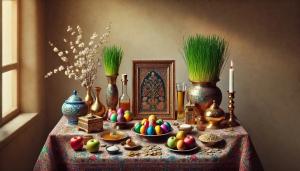Nowruz: Celebrating Persian New Year and the Renewal of Nature
Nowruz: Celebrating Persian New Year and the Renewal of Nature
Have you ever heard of a celebration that marks not just the start of a new year but also the rejuvenation of nature? If you’re curious about this ancient and beautiful tradition, let us introduce you to Nowruz, the Persian New Year.
What is Nowruz?
Nowruz (pronounced “No-rooz”) translates to “New Day.” It marks the first day of spring and the beginning of the new year in the Persian calendar. This celebration dates back thousands of years, rooted in the folklore tradition, and is a time when the world awakens, trees turn green, flowers bloom, and the air feels fresher. It’s a celebration of renewal, hope, and togetherness.
Every year, millions of people around the world come together to honor this vibrant tradition. And for the past six years, we’ve been delighted to celebrate it with you too!

How to Celebrate Nowruz: Setting the Haft-Seen Table
One of the most iconic parts of Nowruz is setting the Haft-Seen table, a display of seven symbolic items that start with the Persian letter “S.” While it might sound like a challenge to find these items, here are a few traditional options:
- Seeb (Apple) – Symbolizing beauty and health.
- Serkeh (Vinegar) – Representing patience and wisdom.
- Senjed (Russian Olive) – A sign of love and fertility.
- Sa’at (Watch) – A reminder of the passage of time.
- Samanoo – A sweet pudding made from wheat sprouts, symbolizing power and strength.
- Sonbol (Hyacinth) – A beautiful flower, representing the coming of spring.
- Sir (Garlic) – Known for its health benefits, symbolizing medicine.
- Sekkeh (Coin) – A wish for wealth and prosperity.
- Sabzeh (Fresh Grass) – Representing rebirth and growth.
Alongside these items, it’s customary to include a mirror (for reflection) and Sabzeh, which beautifully captures the essence of spring and renewal. Also, coloring eggs is a cherished Nowruz tradition, symbolizing fertility, new life, and the vibrant energy of spring, often displayed on the Haft-Seen table to add a touch of brightness and joy! 🌸🥚
More Than Iran: A Global Celebration
Nowruz isn’t exclusive to Iran, it has its roots in Mesopotamia and is celebrated across the globe by various ethnic groups, including Afghans, Tajiks, Turks, and Kurds. It’s a shared tradition that transcends borders, bringing people together to welcome the new season and the new year.
Thirteen Days of Celebration
In Iran, Nowruz celebrations last for 13 days, culminating in a special day called 13bedar. On this day, families and friends head outdoors to enjoy nature and symbolically leave behind any bad luck associated with the number 13. It’s a day of picnics, laughter, and connection with the natural world.
Throughout the 13 days, visiting family and friends is essential. Younger generations visit elders first, paying their respects, and the elders return the favor. It’s a time of reunion, strengthening bonds, and creating cherished memories.
One of the sweetest traditions of Nowruz is Eidi (pronounced as AD), where elders give money or small gifts to younger family members. It’s a token of good luck and blessings for the new year, and it’s one of the most cherished parts of the celebration, especially for children!
What Year Will It Be in Iran After Nowruz?
After Nowruz in March 2025, the Persian calendar will officially transition to 1404. The Persian calendar is solar-based, aligning precisely with the spring equinox, making it one of the most accurate systems and a perfect symbol of renewal and fresh beginnings! 🌸
Why Nowruz Matters
Nowruz isn’t just a celebration; it’s a cultural tapestry that weaves together people from different ethnicities, religions, and traditions. It’s a time to reflect on the past, embrace renewal, and come together in harmony.
So, whether you’re setting up a Haft-Seen table, visiting loved ones, or simply enjoying the beauty of spring, Nowruz is a reminder that every new day is a chance to celebrate life, love, and connection. Join us in honoring this incredible tradition and welcoming the season of growth and renewal.
Happy Nowruz 1404! 🌸
By: Faranak Parkami